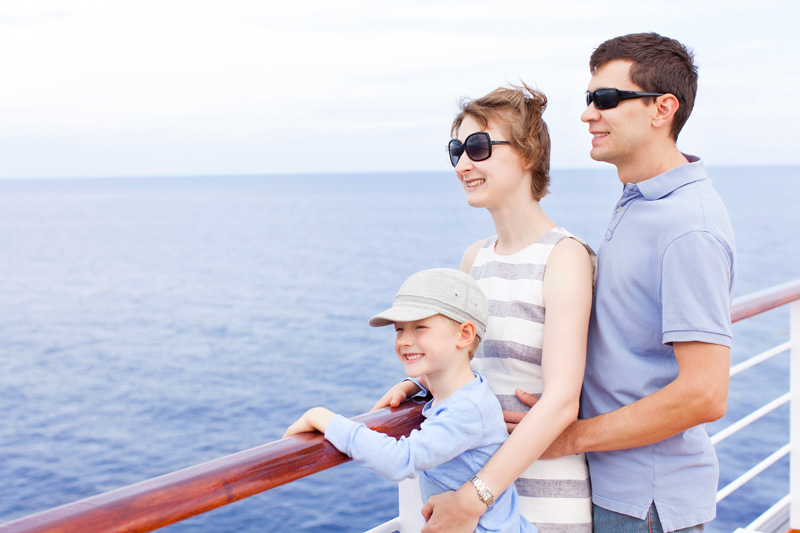Do you wish you could go on a family vacation but think it’s too hard to manage with a child on the autism spectrum? With proper planning, a cruise can be a great way to combine fun and predictability for the perfect autism friendly family vacation.

As a mom of children on the spectrum, for a long time, I was apprehensive about taking my kids on trips due to the planning required and the uncertainty of how they would do in different situations and environments. I hesitated to try a vacation at sea, but now cruises are our favorite type of vacation.
Why choose a cruise instead of another type of autism friendly family vacation? Logistically, cruises can be much simpler. Rather than spend a lot of time booking hotels, finding attractions and restaurants that appeal to different family members, and dealing with airport or traffic hassles, if you live near a cruise port, you can easily board a cruise ship and reduce your itinerary and vacation planning stress.
Cruising with Autism: Planning Tips and Strategies
There are many things you can do to make things run smoother before and during your cruise to help your autistic child and your entire family have a more pleasant experience.
First, plan as much as you can. Find a cabin that will meet your needs and provide as much comfort as possible within your budget. Even though you will be out and about on the ship and when in port, you and your child may need breaks throughout the day. When you are in your cabin, you will want to be comfortable. Balcony rooms are a must for my family since we enjoy quiet time, vistas, and the sounds of the sea, as well as the experience and views of pulling in and out of ports. Having a balcony and a view makes the room seem bigger and less confining.
Regarding cabin location, choosing one more “mid-ship” may have less motion for those concerned about seasickness. Also, selecting a cabin on a quiet floor with just cabins and not a pool, dining area, or busy thoroughfare is a good idea to minimize traffic and noise when resting or if commotion tends to upset your child.
On the topic of noise, ear protection headphones are a must. When common areas do get loud, headphones help with auditory/sensory sensitivities and overwhelm.
When first booking the cruise, be sure you or your travel agent reach out to the cruise line to let them know about the passenger(s) who may have special needs. This will allow you to stand in a shorter line when going through security and check-in and to request a wheelchair if needed for a faster, less stressful experience in the terminal and boarding.
It’s also a good idea to select an early boarding time to avoid the rush and stress of your family or others running late. Arriving early will give you extra time to explore the ship leisurely and have lunch before it gets too crowded. If you checked in your luggage, it’s a good idea to bring a backpack with sensory toys, medications, and necessary items until your luggage is delivered to your cabin. Most everyone wears their cruise card (acts as key and ID) on a lanyard, so either bring one you will enjoy wearing and will look good in photos, or you can buy one on the ship.
If you’re not sure how your child will do on a cruise, it’s a good idea to start with a shorter cruise rather than one that is seven days or longer. To prepare your child for the idea and expectations of a cruise, developing a personalized social story is a helpful way to get the child excited about and familiar with the ship’s layout, ports, attractions, food options, etc. Be sure to include the itinerary (with arrival and departure times for each port and the days at sea), as well as pictures of the actual ship and the attractions you plan to visit at each port. A social story tailored to your child’s level of understanding can help all family members prepare for what to expect and look forward to during the cruise.
A big part of the cruise experience is the dining. If your child does not like to wait for food or is picky about what they will eat, the plentiful buffets offer various options to satisfy various preferences and dietary needs. We enjoy buffets for breakfast and lunch, but for dinner, choose the early reserved seating in the dining room. If your child has allergies or food sensitivities, you can special order the next night’s meal at the end of dinner, and the waitstaff will bring it out quickly to your table the next day. By having a reserved table and time, you will likely have the same waitstaff and more predictability for your child. On the flip side, waiting for an available table on a walk-in basis at different times each evening of your cruise will likely result in being seated at a different table and having different waitstaff each night. It may increase your child’s stress level. My children loved having a predictable evening routine each night of the cruise: dressing up for dinner, sitting at a familiar table, having the same attentive waitstaff bring them lots of delicious food we had preselected, and then going to a show.
Another tip I can share for an autism friendly family vacation is to avoid crowded areas of the ship when possible. For example, instead of cutting through the casino, avoid sensory overload by finding a more quiet, less traveled route. Also, your family might find more calm in a different pool or even a hot tub instead of the main pool.
When planning port activities, hiring a private guide, or exploring a destination alone might be less stressful than joining a large group on a crowded ship excursion with little to no flexibility or ability to adjust the pace to meet your child’s needs.
If you feel you might need an extra pair of hands or additional help, there are companies, such as Autism on the Seas, that cater to helping families with autism on cruises and provide respite services so parents can have some downtime. Bringing relatives or helpers can also give caregivers a break and can be a great opportunity for family fun and adventures.
Remember, this is a vacation, so have fun and be okay with allowing downtime and changes in plans and routines. Even with the best efforts, there may still be some anxiety or meltdowns. So, after everyone has a chance to relax, cool down, and recharge, go back out there and explore what the cruise offers. Your kids might just surprise you and make some great memories of exciting new experiences.
Mary Ann Hughes, MBA, is a Special Needs Certified Divorce & Transition Coach and Founder of Special Family Transitions LLC. For more information and resources on special needs divorce or transitions, please visit SpecialFamilyTransitions.com and follow on Facebook, Instagram, and YouTube. You can also reach Mary Ann at maryann@specialfamilytransitions.com.






